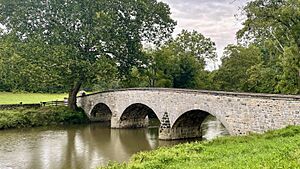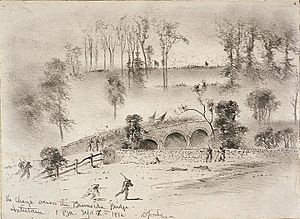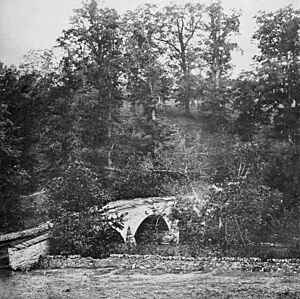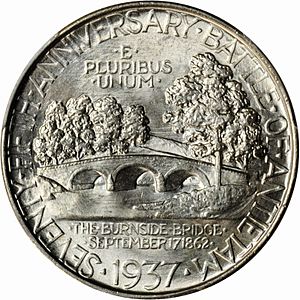Burnside's Bridge facts for kids
Quick facts for kids Burnside's Bridge |
|
|---|---|
 |
|
| Coordinates | 39°27′02″N 77°43′55″W / 39.45056°N 77.73194°W |
| Carries | Pedestrians |
| Crosses | Antietam Creek |
| Locale | Sharpsburg, Maryland |
| Characteristics | |
| Design | Arch |
| Material | Stone |
| History | |
| Opened | 1836 |
Burnside's Bridge is a famous spot on the U.S. Civil War Antietam National Battlefield. It is located near Sharpsburg, Maryland in northwestern Maryland. This historic bridge was built in 1836. It became very important during the Battle of Antietam in 1862.
Contents
Burnside's Bridge: A Civil War Landmark
Building a Bridge for Farmers
In the early 1800s, people in Washington County, Maryland needed better roads. They decided to build fourteen new bridges. Burnside's Bridge was one of five designed by a skilled builder named John Weaver. Its construction finished in 1836.
Local farmers, who were part of the Dunker community, built the bridge. It has three arches and is 12 feet (about 3.6 meters) wide. The bridge stretches 125 feet (about 38 meters) across Antietam Creek. Farmers used it to bring their crops and animals to market in nearby Sharpsburg.
The bridge's arches are made from limestone found nearby. Stone walls hold up the road and have protective barriers called parapets. Building the bridge cost about $3,200 back then. Today, that would be worth much more.
The bridge has other names too. Some people called it "Rohrbach's Bridge" after a local farmer, Henry Rohrbach. It was also known as "Lower Bridge." This was because there were two other bridges, the "Upper Bridge" and "Middle Bridge," further upstream. All these bridges helped people and goods cross the creek.
The Battle for the Bridge
The bridge played a huge role in the Battle of Antietam in September 1862. This was a major battle during the American Civil War. About 500 Confederate soldiers from Georgia defended the bridge. Their leaders were General Robert Toombs and Henry Benning.
For several hours, these brave Confederates held off many attacks. They faced soldiers from the Union Army's IX Army Corps. The Union leader was Major General Ambrose E. Burnside. The bridge later got its name from him.
Who Fought for the Bridge?
The Union soldiers tried to cross the bridge many times. First, Colonel George Crook's Ohio brigade tried. They were supported by Edward Harland's brigade. But the Ohio soldiers went too far upstream.
Then, the 11th Connecticut Infantry Regiment found the bridge. They fought against Toombs's Georgians. The 11th Connecticut suffered many losses and had to retreat quickly.
The Union's second attempt was by James Nagle's brigade. The 2nd Maryland and 6th New Hampshire Infantry rushed towards the bridge. But Georgia sharpshooters stopped them halfway. Toombs's 450 Georgians managed to hold off 14,000 Union attackers.
Finally, two Union regiments made a strong push. The 51st New York Volunteer Infantry and the 51st Pennsylvania Infantry attacked. They were part of Brigadier General Edward Ferrero's brigade. They paused near the bridge walls to fight the sharpshooters. Then, they charged across the bridge and captured it. This attack took many hours longer than expected.
A Historic Site Today
After the Civil War, the U.S. government bought the bridge. It also bought the land around it. This area is now part of the Antietam National Battlefield. Cars are no longer allowed to drive across the bridge. The old farm roads leading to it have grown over with grass.
However, people can still walk across the bridge. It is one of the most photographed bridges from the Civil War. In 1937, the bridge was even shown on a special coin. This coin was a Battle of Antietam half dollar.




